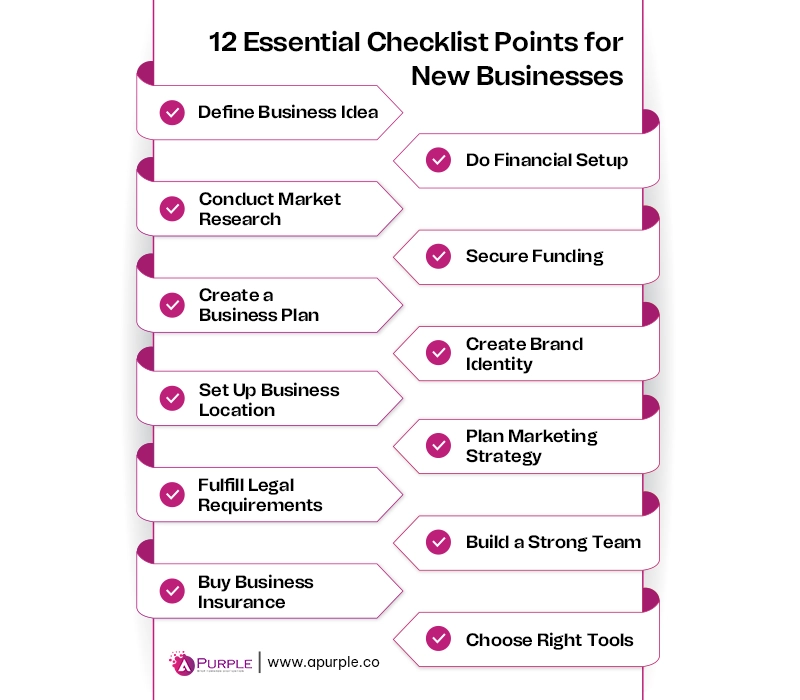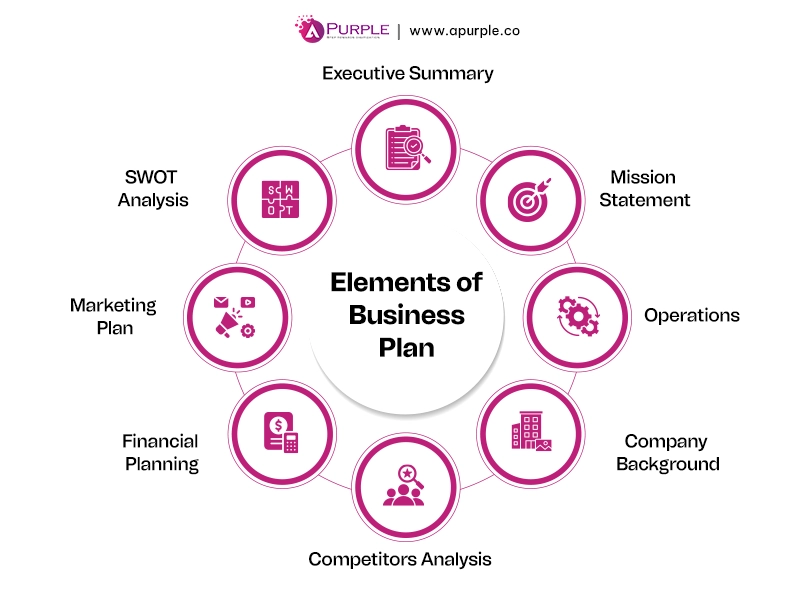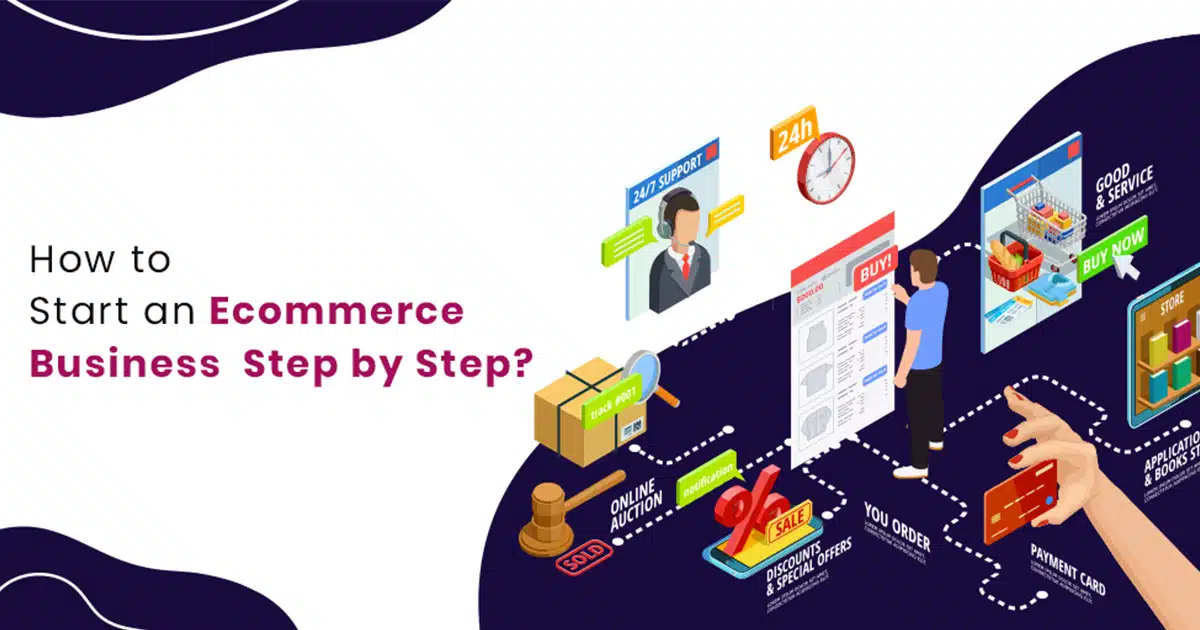
Got a startup idea? That’s just the first step of your entrepreneurial journey. There is an entire startup checklist you need to follow to make your process smooth. From legal steps & product building to branding & marketing, managing everything can quickly get overwhelming.
That’s why a solid business checklist isn’t just helpful; it’s essential. You can step-by-step plan your startup journey, stay focused, save time, and help you avoid costly mistakes.
Using our years of experience in assisting hundreds of entrepreneurs at aPurple, we’ve created a 12-point startup checklist that covers everything you need to know for staying on track from day one. Whether you are launching your first business or working on your next big idea, this guide is best to start smart.
Let’s get into the must-do steps for your business.
Startup Checklist: How to Launch a Business in 12 Steps
Creating a checklist becomes an invaluable asset if you are starting a business. It ensures that you don’t miss any important steps along the way. Here’s your ultimate new business checklist to guide you through various steps of your startup journey— from selecting a startup business model to the final market launch.
- Define Your Business Idea
- Conduct Market Research
- Create a Business Plan
- Set Up Your Business Location
- Fulfill Legal Requirements
- Buy Business Insurance
- Do a Secure Financial Setup
- Find Investors, Mentors, & Strategic Partners
- Build Your Brand Identity
- Work On Marketing Strategy
- Build a Strong Team
- Choose the Right Technology Stacks
1. Define Your Business Idea
Your business idea starts your journey to becoming an entrepreneur. A clear and viable idea is the heart of launching a successful startup. Make sure your offering addresses the problem or need of the market. Search for answers to the following questions to solve this phase.
- What are the pain points of my industry?
- Does my idea become a product or service?
- Is my idea good for generating profitable revenue?
- Does my product solve the problems of my industry?
- Who is my target audience?
- How is my product or service different from those of my existing competitors?
You can refine your vision, purpose, and value propositions by having clarity on business ideas. Ultimately, this foundational step sets the tone for everything that is going to be followed.
Tools That Can Help You Check the Feasibility of the Business Idea:
- MindMeister: Do mind mapping of your ideas and visualize the connections between concepts and opportunities.
- Trello: Organize your thoughts, to-dos, and ideas.
- Notion: Keep everything in one place for easy reference.
Pro Tip: Don’t rush this step. Take enough time to brainstorm ideas by talking to potential customers. Feedback from the real market is invaluable, and it can help you refine your concept ASAP.
2. Conduct Market Research
Before you take any costly step further, a great understanding of your market is a must thing for you. Market research is super essential to identify your target audience, industry trends, and competitors’ study.
But do you know how to do this? Just find the right answers to the following to get the correct status of your chosen market.
- Who will be your ideal customers?
- What are your customers’ pain points and needs?
- Who are your main competitors?
- What do your competitors offer, best or poor?
- What are the new opportunities in your industry?
- What are the challenges in your industry?
- What are the gaps in your market?
- What are the new and upcoming trends in your industry?
Tools That Can Help You Do Effective Market Research:
- Google Trends: Learn about your market trends and search volumes related to your business.
- SurveyMonkey: Create and distribute surveys to collect your real users’ opinions and feedback.
- SEMrush or Ahrefs: Helps in competitor analysis and finding search trends.
Pro Tip: First, start with primary research, such as interviews or surveys, to get valuable feedback from potential customers. This real-world data will give you useful information that secondary research (like industry reports) can’t.
3. Create a Business Plan
Your business plan is the map of your success path. It’s a detailed document that needs to be prepared for taking serious actions on business goals, strategies, and financial projections. With a well-crafted non-tech or tech business plan, you can stay on track, secure investors, and manage consistent growth.
- Executive Summary: Need an overview of your business idea, goals, and vision.
- Market Data Analysis: Clear info on target audience, competitors, and industry landscape.
- Business Model: Define which business model is best to make money from your idea. Will it be a subscription model, a one-time fee, or a freemium offer?
- Financial Plan: Create a proper estimation of project expenses, revenue, and profitability.
- Marketing Strategy: Plan on promoting your product or service. Decide which channels or platforms are best to reach your audience easily.
Tools That Help You Create Business Plan Easily:
- LivePlan: An easy-to-use tool to create complete business plans with custom templates.
- Canva: Design an eye-catching presentation on a business plan to impress investors or partners.
Pro Tip: A business plan is not just an ordinary document, it’s a living document. As your business evolves, so should your plan. Keep a habit of regularly visiting and updating it based on changing circumstances and market conditions.
4. Set Up Your Business Location
Whether you work from a physical office, retail location, or a home-based business, wherever you set your business operations plays a key role in your success. Choosing the right location to execute business processes can enhance visibility, productivity, and customer satisfaction. Find out the answers to the following questions to choose a productive location for your dream business.
- Do you need a retail space, office, industrial site, or warehouse?
- Will the location make it easy for customers to find and visit your business?
- Does the space meet your size requirements for equipment, inventory, or office setup?
- How will the location impact your brand image?
- What are the local regulations and zoning laws?
- Does it have the right infrastructure, such as high-speed internet or power supply?
- What is the lease length and renewal process?
- Are there any rent escalations or flexible terms?
- Will you need to make significant renovations to meet your business needs?
- Are there any hidden fees or costs (e.g., maintenance, common area charges)?
- Do you have the option to modify the lease if your business needs to change?
Tools That Help You Benefit With Location:
- WeWork: Flexible coworking space where you can find professional settings and networking opportunities.
- Google My Business: Setting up a Google My Business account will improve your online visibility if you have a physical location.
Pro Tip: Even if you are launching small or remotely, make sure to consider a “home base” where you can conduct meetings and collaborate. This doesn’t need a complete office setup – you can leverage coworking spaces to find professional settings at affordable cost.
5. Fulfill Legal Requirements
Before you step ahead with the marketing, sales, or hiring part, getting done with the task related to legal formalities is a necessary step for your new business. The legal framework you choose will determine your operational structure, applicable tax, and how you protect your intellectual property.
If you are having trouble setting up your startup in terms of business plan and legal requirements, then it’s better to hire startup consulting service providers like aPurple. We can help you with everything regarding executing your startup idea.
- Register Your Business: Select an appropriate business structure from LLC, Corporation, or Sole Proprietorship, considering liability, taxes, and ownership. This decision will impact everything from personal liability to taxes.
- Gain Necessary Permits: As per the chosen industry and location, you may need licenses or permits to operate your business legally.
- Trademark and Protect Intellectual Property: Don’t skip trademarking your unique business name and logo. If you ignore this, there is a possibility of your business name, logo design, or app design being stolen by any other organization.
Tools That Help You Set Up Your Business Legally:
- LegalZoom: Provides an easy and affordable way to set up your business entity, trademarks, and more. Simply help you form your LLC or INC.
- Rocket Lawyer: This tool makes legal documents easy to understand and gets you to take lawyer consultations.
Pro Tip: With the thought of saving money, don’t choose the cheapest legal structure. Select the one that offers the most flexibility for business growth. If you have a plan to seek investors and scale quickly, then an LLC or Corporation might be a great choice than opting for a sole proprietorship.
6. Buy Business Insurance
Business insurance is the best precaution before something hurts your company. As soon as you hire your team, set up your business location, or start to expand your business, you will need liability insurance at one stage. Mostly, liability insurance is meant to cover you in case someone gets injured on your premises or because of your company’s activities.
- Professional Liability: If any error or elimination can result in financial loss for your client, then this insurance helps you cover it.
- Worker’s Compensation: Covers all the medical expenses and lost wages for your employees who get injured while working for your company.
- Business Interruption Insurance: In case your business is forced to close temporarily, then this insurance helps you cover lost revenue.
- Property Insurance: As the name suggests, this one covers your physical property. It includes everything from company equipment to warehouse space.
Popular Platforms That Help You Get Business Insurance at Ease
- Insureon: Help you compare quotes for general liability, professional liability, & workers’ compensation. Recommended for small businesses.
- CoverWallet: You can compare and purchase your customized insurance based on your business type and needs.
Pro Tip: Buy insurance that can reduce your business-specific risks. Never settle for a one-size-fits-all policy. Make sure to review your insurance coverage annually. Always consult with an expert to avoid gaps in protection.
7. Do a Secure Financial Setup
Business growth can be set on pause if you are not managing your company’s money wisely. Create a business bank account, understand your taxes, and hire a person who can manage your finances correctly. In this way, you can save yourself from the stress and headaches of the future.
The common finance tracking tasks include:
- Income statements
- Cash flow statements
- Bills and invoices
- Balance sheets
- Payroll
- Expenses
- Quarterly financial statements
- Tax returns
- Open a Business Bank Account for your company money to avoid legal complications.
- Create a Budget and Financial Plan to understand your initial capital, possible revenue, and required funding.
- Hire an Experienced Accountant to guide you in tax planning, expenses, and financial strategies. It’s worth the investment.
Tools to Succeed Your Business in Terms of Finances
- QuickBooks: This tool helps you easily manage and track your income, expenses, and taxes in real-time.
- Wave: A free tool for small businesses that helps you with invoicing and accounting.
Pro Tip: Don’t rely on estimations to define your startup budget. Always make a habit of breaking down every cost to the penny, including hidden costs like software subscriptions, taxes, & unforeseen legal fees. Accurate forecasting gives you control over cash flow.
8. Find Investors, Mentors, & Strategic Partners
“When seeking investors, it’s not just about the capital; it’s always about the value they bring. Find investors who are willing to be mentors and actively support your growth – not just those looking for a quick return. The right investors can offer connections, advice, and credibility that boost your success.” – Paresh Sagar, aPurple CEO
As a startup, every company wants to scale, but if you want to scale fast, then having the right partner by your side is crucial. Whether you are looking for an investor, mentor, or strategic partner, these relationships can make a huge impact on the future of your business.
Some common funding options include:
- Personal savings
- Family and friends
- Finding Investors
- Bank loans
- Venture capital
- Crowdfunding
- Seek Investors Carefully: Don’t make the mistake of getting investments from anybody. Only partner with investors who are really interested in your vision and bring something more to the table than money.
- Find a Mentor: A great mentor can provide invaluable advice, saving you from making costly business mistakes and helping you when needed.
- Collaborate with Other Brands: Find opportunities to partner or co-market with other popular companies.
Ways That Can Help You Seek Investors at Your Limited Budget Phase:
Partner with aPurple: You are working with a limited budget but want to scale up. Then connect with us – we can become your tool, investor, and partner in one go. We are not just an ordinary startup app development company; we are a partner who has helped turn unique thoughts into actions. With your investment, we add our money and expertise in exchange for equity and bring years of experience in business development. It’s simple: if you collaborate with us, you can get money, an expert team, and years of experience in one plate.
9. Build Your Brand Identity
The next step in your startup checklist is building your brand. This is the way to get in front of the eyes of your customers. From creative logo design to creating a brand voice, building a recognizable and trusted brand is necessary to stand out among a number of competitors. You can hire branding service providers to help you grow fast with strategic brand-building from a startup.
- Give a Definition to Your Business: Define what values, mission, and vision will be delivered by your business. Give your startup brand personality so it resonates with your customers.
- Develop a Compelling Website: Create a simple, easy-to-navigate, and user-friendly website for your customers. Take help from an experienced website development company in your industry to build a digital storefront for your startup.
- Build a Social Media Presence: When thinking about creating a brand, you can leverage social media free of cost. Engage your audience by regularly posting updates about your product, mission, and company culture.
Building a great business identity helps you create trust in your customers and make them buy from you.
Pro Tip: Your brand needs to feel “human.” When engaging in social media, showcase your behind-the-scenes processes, team members, and values. Customers don’t just want product details all the time; they want to feel like they are part of your journey.
10. Work On Marketing Strategy
To get noticed, the next step in the business checklist is marketing. You must create a fruitful strategy to build awareness of your startup and attract customers.
- Develop a go-to-market strategy by utilizing social media ads (e.g., Facebook, Instagram), email marketing (e.g., Mailchimp), PPC (e.g., Google Ads), etc. This will work best to reach the right audience.
- Write blogs on websites, create videos, or host webinars that educate your customers regarding your product or services and build trust.
Pro Tip: Start a small business, but scale fast. Don’t get confused after going with multiple marketing channels. Focus on one or two platforms where your target audience is most active.
11. Build a Strong Team
The intensity of building a strong business is directly proportional to the people who support it. A big company needs a big size team. As you grow from a small business to an enterprise, having a solid foundation team is crucial to promise your success.
Not having proper guidance on how to hire developers, project managers, financial experts, or sales professionals in your team leads to costly losses. In fact, having a bad team is one of the biggest reasons for 90% of startup failures. Here, check some other key reasons behind the failure of unique business ideas.
- Define Roles Clearly: Before hiring, make sure you have clarity on the roles and responsibilities you have to fill. Don’t hire just to fill the gap in the team.
- Find Culture Fit: Skills are important, but they can be learned, not characters! Finding a person who has a personality and is in alignment with your company’s values is essential. Giving your employees a healthy work environment can drive productivity and business growth.
- Outsource If Needed: If you can’t find the right talent at the right price in in-house hiring, then you can outsource your dedicated team. Hire developers, project managers, expert consultants, etc., crucial roles from offshore or nearshore outsourcing models.
- Set Clear Expectations & Goals: Ensure your team has a detailed awareness of everything you are expecting from them and what success looks like from your perspective. This will prevent misunderstandings and work delays.
Key roles for hiring a new business team include
- Marketing and sales professionals
- Product development and management
- Customer service representatives
- Financial and legal advisors
Pro Tip: Never rush on hiring! Take enough time to find the right people for your core team. Wrong hiring could slow down your progress or undermine your culture.
12. Choose the Right Technology Stack
The tools and software you choose to execute your internal operation and track business growth can make or break your efficiency. From accounting software to project management tools, having the right tech stack can help you streamline your front-office and back-office business operations.
CRM and ERP software are popular for managing business processes. CRMs are for customer relationship management, and ERPs are for streamlining business processes such as HR and inventory management.
Generally, startups need CRM software at the initial level. You can go for a ready-made solution or develop your own to match business needs by collaborating with a top software development company like aPurple.
- Choose your business software wisely, considering your current major needs.
- Try to automate tasks where possible, like email marketing, customer onboarding, and invoicing, to save you time.
- Invest in secure and encrypted systems to avoid costly security breaches.
- If needed, then opt for SaaS development services rather than adjusting with ready-made solutions that lack in serving your business needs.
Tools for Streamlining Internal Operations:
Pro Tip: Don’t go for all-in-one software unless it truly meets your needs. Instead of getting stuck into comprehensive systems, you can use specialized tools for specific needs, which is mostly more effective and scalable.
Final Words
Starting a business is absolutely not an easy task; it’s exhilarating, challenging, and rewarding. With the right strategy, a clear startup checklist, and a team of passionate individuals, you can turn your unique business idea into a popular enterprise. Keep this new business checklist with you to guide your startup journey. Remember, your success is just around the corner!
If you still have any doubts or want to consult regarding executing your creative business idea, then you can connect with aPurple anytime. From strategic planning to successful launch, we’re here to guide you every step of the way, ensuring your startup journey is as smooth and successful as possible. We helped 800+ startups with the help of our expert consults to bring their startup dream alive. Next, let’s make yours.
Frequently Asked Questions






